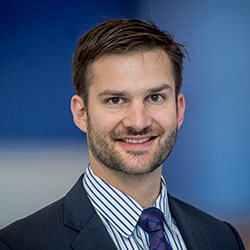The Latest in Pediatric Cranial Base Surgery: A Q&A With Dr. Randall Bly
June 5, 2019
 What are cranial base diagnoses?
What are cranial base diagnoses?
Dr. Randall Bly, principal investigator, Seattle Children’s: These are diagnoses of tumors or other lesions in the middle of the head. The cranial base is also sometimes called the skull base. Diagnoses can include nasal dermoids, orbital tumors, cholesterol granulomas, craniopharyngiomas, schwannomas, paranasal sinus tumors, pituitary adenomas, inverted papillomas, neurofibromas, angiofibromas, glomus tumors, esthesioneuroblastomas and cerebrospinal fluid (CSF) leaks.
Does Seattle Children’s treat children with cranial base diagnoses?
Dr. Bly: Yes. In order to provide the highest-quality care to children with these diagnoses, Seattle Children’s recently created its own Cranial Base Program. It is one of the only pediatric cranial base programs in the nation, and the only one to offer treatment from a multidisciplinary care team. We treat children of all ages who come to us with a wide variety of cranial base diagnoses. In recent months, we’ve seen children with JNA, CSF leak, vascular malformation of the skull base (arteriovenous malformation, venous malformation), benign cysts (cholesterol granuloma, epidermoid cyst), osteoma, malignant lesions (rhabdomyosarcoma) and inverted papillomas.
What is involved in cranial base surgeries at Seattle Children’s?
Dr. Bly: Typically, multiple surgeons work together to carry out the surgical plan. In some cases, that is complete resection, and in others it may be a biopsy. These are minimally invasive procedures that result in less pain and faster recovery time for the patient. Our approach involves a team of experts from Otolaryngology and Neurosurgery that expands as needed to include physicians from Endocrinology, Ophthalmology, Facial Plastics and Reconstruction, Hematology, Oncology, Pediatrics and Interventional Radiology. The team holds a conference prior to surgery to determine the most effective and safest way to treat the patient with the least amount of risk. Each child is different, and a customized treatment plan is made for every one of our patients. Our patients are often cared for after surgery by doctors and nurses in our Pediatric Intensive Care Unit (PICU).
Why is it important for kids to be seen at a cranial base program that’s just for children?
Dr. Bly: Expertise in cranial base surgery from Otolaryngology and Neurosurgery is critical, but the way that care is delivered often differs in pediatric patients. For example, postoperative care may be modified compared to how care is routinely provided in adults so that kids aren’t required to undergo office-based procedures. Instead, a brief anesthetic may be used to make sure the child stays safe and avoids discomfort. Our team works with each patient and family to develop a surgical and postoperative care plan that considers the individual needs of the young patient and their family, based on the diagnosis.
What should providers know about recognizing and diagnosing kids with cranial base lesions?
Dr. Bly: Patients may present with a variety of symptoms. Pituitary lesions can present with hormonal imbalance and visual disturbance. Other lesions can present with headache or a mass in the nose or oropharynx. JNA, which is one of the more common cranial base lesions, can present with nasal obstruction and epistaxis.
I’ve heard of JNA but am not sure what it is. What is it, and how does it present?
Dr. Bly: JNA stands for juvenile nasopharyngeal angiofibroma. It’s typically present in male teenagers with epistaxis and a nasal mass. It’s an uncommon but important diagnosis to make, and one we see a lot of at Children’s. Patients are evaluated with imaging and biopsy. Treatment involves a preoperative embolization performed by an interventional radiologist, immediately followed by endoscopic surgical resection.
Have there been significant surgical advancements for cranial base lesions?
Dr. Bly: Yes — this field is changing all the time. Our pediatric specialists use groundbreaking surgery techniques to help us prepare for complex surgeries and provide the best care for patients. Our advanced surgical planning methods may include 3D printing of the patient’s head or using reconstructed planning software to analyze different surgical pathways.
If you are wondering what reconstructed planning software is, the CT and MRI 2D images can be somewhat challenging to interpret, especially for nonsurgeons. We “reconstruct” those images into a 3D view so that certain components are well visualized. In many cases, it allows us to see the lesion or tumor in 3D, as well as adjacent critical structures such as the optic nerve or carotid artery. With a “reconstructed” view, it allows us to show an image to the patient and their family, so they can better make sense of it. When we go one step further and produce an actual physical model (3D printed model), it similarly makes it easy for patients and families to visualize and understand.
What new research is underway?
Dr. Bly: There is a lot going on to help us further improve how we plan and guide surgery to make it safer, more effective and with quicker recovery times for patients. Children’s surgeons, in partnership with the engineers from the University of Washington BioRobotics Lab, are collaborating to develop innovative software that plans, guides and analyzes cranial base surgeries. The tracking software works like a GPS of the patient’s CT scan and assists surgeons on the location of their instruments and endoscope as they work. We’re currently driving the next step of this technology in which the software will send an alert if the tool deviates from the surgical path. Although other groups are working on similar research, ours is unique, in that our surgeons work closely with the engineers. We have previously received funding from the National Institutes of Health (NIH) for this type of work.